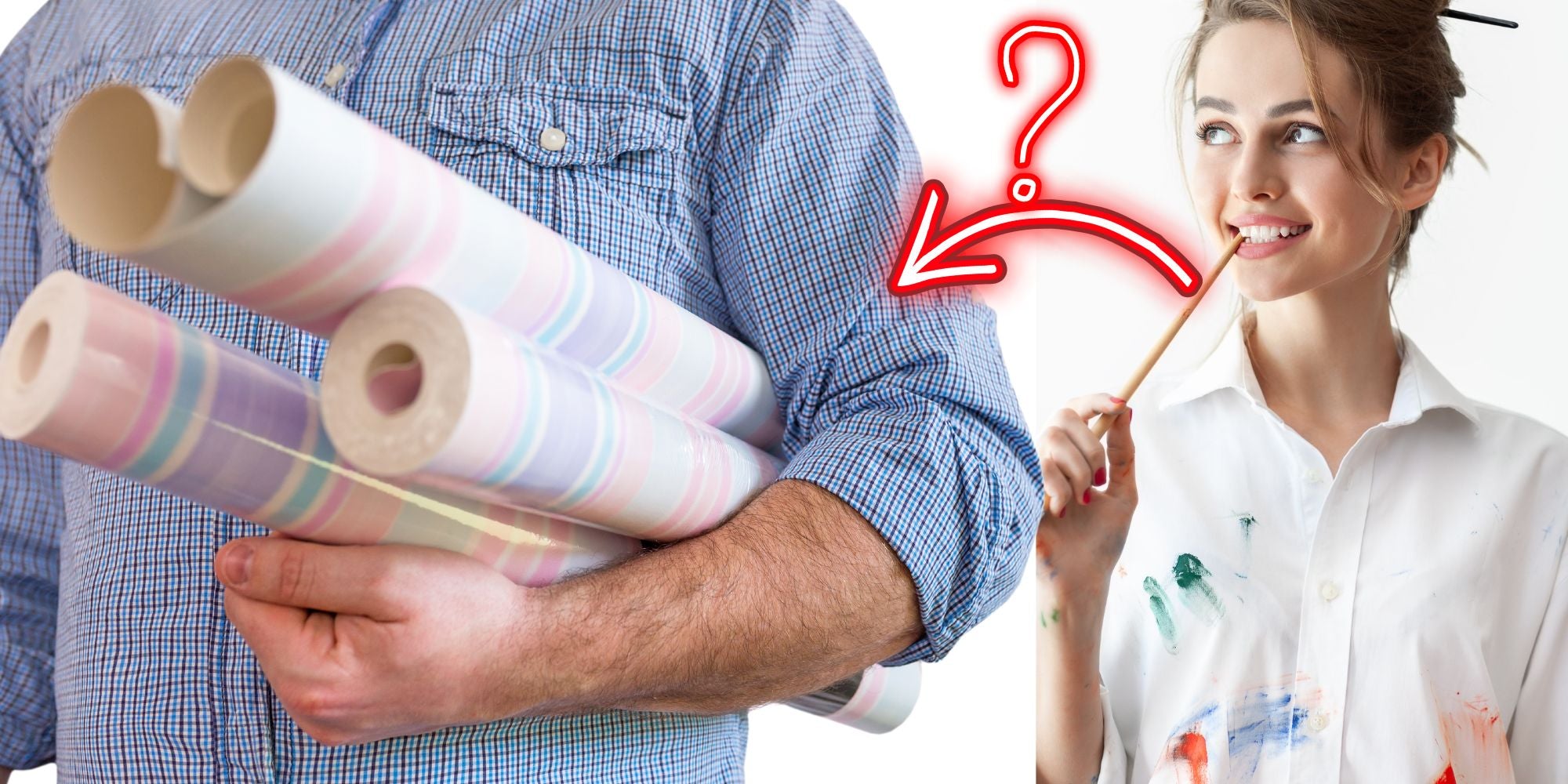Painting over wallpaper is a question many people ask themselves when considering how to refresh the look of their walls without undertaking major renovation work.
This technique, although practical, requires some preparation and knowledge to avoid pitfalls and achieve a satisfactory result. This article explores the possibility of painting over wallpaper, the precautions to take, as well as the advantages of calling on a professional.
Key Points
- It is possible to paint over wallpaper by using suitable paint and preparing the surface correctly.
- The application of an undercoat or filler, followed by two coats of paint, is recommended to even out the surface.
- For an impeccable and lasting result, it is advisable to call on a professional painter.
Is it possible to paint on wallpaper?

The basics to know
Before diving into the adventure of painting wallpaper, it is crucial to master a few basics. Know if wallpaper can be painted is the first question to ask yourself. The answer is yes, but not without preparation. There are key factors to consider, such as the type of wallpaper and its condition.
Here are some key things to check before you begin:
- Humidity level : Make sure the walls are not damp.
- Wallpaper type : Some wallpapers absorb more paint than others.
- Wallpaper Condition : It must be clean, dry and well adhered to the wall.
These elements will not only determine the feasibility of your project, but will also influence the choice of paint and the application method. Taking the time to properly prepare the ground is essential for a satisfactory result.
Preparing wallpaper before painting
Before diving into the adventure of painting wallpaper, there are a few crucial steps that should not be overlooked. Clean the wallpaper is the first essential step. Use a slightly damp brush or sponge to remove any dust or dirt. This is essential to ensure good paint adhesion.
Once you are done cleaning, make sure the wallpaper is completely dry. This is where the step ofapplying an undercoat. This preparation is crucial to obtain a uniform and durable rendering. Here is a quick guide:
- Cleaning the wallpaper with a brush or sponge.
- Complete drying of the wallpaper.
- Application of an undercoat to even out the surface.
Remember, some wallpapers can be problematic:
- Wallpapers that are too thin: risk of peeling.
- Old or colored wallpapers: risk of fading.
- Wallpapers with raised patterns: risk of irregular marks.
When in doubt, it is always wise to consult a professional. This preparatory step is essential to ensure the success of your wallpaper painting project.
Paint selection and application
After preparing our wallpaper, we come to the crucial step: choosing the paint and its application. It is essential to choose a quality acrylic paint, easy to clean and durable. Why? Because it adapts better to the wallpaper and guarantees a more uniform final result.
Here is a short guide to the application:
- Start by clearing the corners and contours of doors or windows.
- Use a fine brush for touch-ups and a roller for large areas.
- Apply the paint working in 1 m² areas, first going back and forth from top to bottom, then from right to left.
Remember, applying two coats of paint is essential for a flawless finish. And of course, between each coat, allow time for the paint to dry properly. It's a little patience for a result that's worth it!
Why call a professional?

The risks of misapplication
We often think that painting on wallpaper is child's play. But, watch out for traps ! If you're not careful, you can quickly end up with a wall that's looking grumpy. Here are some of the risks you run by taking it lightly:
- Wallpaper that is too thin and peels off when painted.
- An old colored wallpaper that decides to play the chameleon and lets stains appear under the new layer.
- What about raised patterns? They can leave unpredictable marks, unless you think to apply a coating first.
That's why we can't say it enough: when in doubt, it's best to leave it to the pros. They know how to avoid these pitfalls and ensure that your wall remains chic and hassle-free.
The benefits of professional work
We all know that trying to do things ourselves can be tempting, especially when you think about the potential savings. But when it comes to painting over wallpaper, hiring a professional has some significant advantages. The quality and durability of the result are at the top of the list. A pro will know how to choose the right materials and apply the paint in such a way that the result is not only beautiful but also durable.
Here are some key benefits:
- Technical expertise : A professional knows the specific techniques for painting on wallpaper.
- Save time : Letting a professional do it also means giving yourself more time for yourself.
- Quality guarantee : With a professional, the result is guaranteed, thus avoiding frequent touch-ups.
- Personalized advice : A pro can offer advice tailored to your situation and tastes.
All in all, even though it represents a higher initial investment, the long-term benefits more than justify the expense. Don't underestimate the importance of a job well done, especially in something as delicate as painting wallpaper.
How to choose the right craftsman?
After deciding to entrust our project to a professional, the question that haunts us is: How to choose the right craftsman? It's not an easy task, but there are a few tips that can help us a lot.
First of all, it is essential to ask for quotes from several craftsmen. This allows us to compare prices, but also to have a more precise idea of their approach and their seriousness. Here is a simple list so as not to get lost along the way:
- Request quotes from several craftsmen.
- Check references and reviews from previous customers.
- Make sure the craftsman is insured and qualified.
- Discuss your expectations and make sure they are understood.
Then, don't hesitate to meet the craftsmen in person. This step is crucial to establish a bond of trust and to ensure that the craftsman understands our expectations and specific needs. Good communication is the key to a successful collaboration.
Finally, choosing a craftsman is not just about comparing prices. It is important to take into account the quality of the work offered and the feeling you have with the craftsman. After all, we are going to entrust him with our home, so it is essential that we get along well. Choosing the right craftsman also means choosing someone we trust.
Hiring a professional for your specific needs is not only a question of quality, but also of peace of mind. On our site you will find a range of services tailored to your requirements. Don't wait any longer, visit our site now to find out how we can help you achieve your goals. Now is the time to make the choice for expertise and efficiency.
Conclusion
In short, painting over wallpaper is completely doable and can be an excellent alternative to give your interior a new look without having to undertake major renovation work. However, for the result to live up to your expectations, it is crucial to choose the right paint, properly prepare the surface and, ideally, call on a professional to ensure an impeccable result. Don't forget to take into account the specificities of your wallpaper to avoid unpleasant surprises. So, are you ready to transform your space with a little paint?
Frequently Asked Questions
Can you paint over any wallpaper?
Yes, it is entirely possible to paint on any type of wallpaper, provided you use suitable paint and prepare the surface correctly.
What precautions should I take before painting over wallpaper?
It is recommended to clean the wallpaper, apply an undercoat or filler to even out the surface, and wait until the surface is completely dry before painting.
Why hire a professional to paint over wallpaper?
Calling on a professional ensures an impeccable and lasting result. The painter artisans are equipped and have the necessary expertise to manage the specificities of each type of wallpaper.






